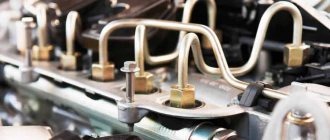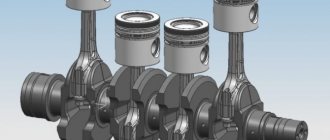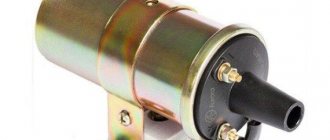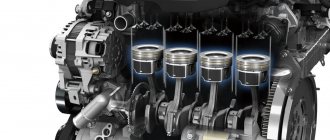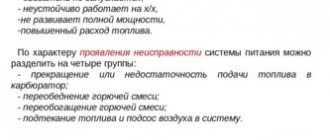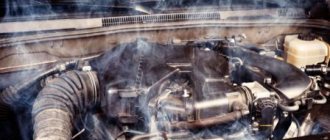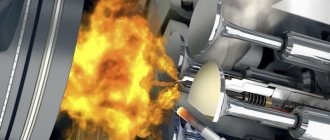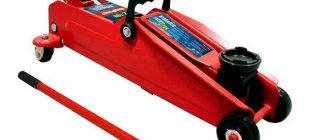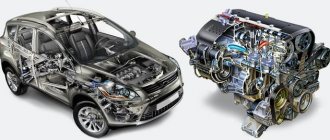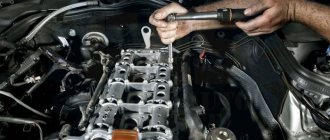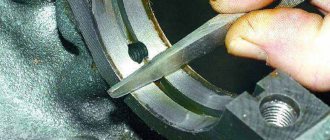DEFECTIVE ENGINE
After disassembly, thoroughly clean, rinse and dry all parts.
1. Clean the piston head from carbon deposits. If the piston has burrs, burn marks, deep scratches, or cracks, replace the piston.
Clean the grooves for the piston rings. It is convenient to do this with a piece of an old ring.
2. Clean the oil drain holes with a suitable piece of wire.
3. Check the clearances between the rings and grooves on the piston.
Nominal clearance, mm:
upper compression ring A. . . . . . .0.04–0.075
lower compression ring B. . . . . . . .0.03–0.065
oil scraper ring B. . . . .0.02–0.055
The maximum permissible gap for all rings is 0.15 mm.
4. The clearances can be most accurately determined by measuring the rings and grooves on the piston. To do this, measure the thickness of the rings with a micrometer in several places around the circumference.
5. . then, using a set of feeler gauges, measure the width of the grooves in several places around the circumference. Calculate the average clearance values (the difference between the ring thickness and the groove width). If at least one of the gaps exceeds the maximum permissible, replace the piston with rings.
6. Measure the gaps in the ring locks by inserting the ring into a special mandrel. If there is no mandrel, insert the ring into the cylinder (in which it worked), using the piston as a mandrel, push the ring into the cylinder so that it is installed evenly in it, without distortions.
7. . and use a feeler gauge to measure the gap in the ring lock. The nominal gap should be 0.25–0.45 mm, the maximum permissible (as a result of wear) is 1.0 mm. If the gap exceeds the maximum permissible, replace the ring.
8. If the gap is less than 0.25 mm, carefully file off the ends of the ring with a file.
9. Check the clearances between the pistons and cylinders. The clearance is defined as the difference between the measured diameters of the piston and cylinder. The nominal gap is 0.025–0.045 mm, the maximum permissible is 0.15 mm. If the gap does not exceed 0.15 mm, you can select pistons from subsequent classes so that the gap is as close as possible to the nominal one. If the gap exceeds 0.15 mm, bore the cylinders to the next repair size and install pistons of the corresponding repair size. Measure the diameter of the piston at a distance of 55 mm from its bottom in a plane perpendicular to the piston pin.
Rice. 4.15.
Cylinder measuring locations
10. Then measure the diameters of the cylinder in two perpendicular planes
(Fig. 4.15) (along B and across A of the cylinder block) and in four belts (1, 2, 3 and 4). For this you need a special device - a bore gauge.
11. When replacing parts of the connecting rod - piston group, it is necessary to select pistons to cylinders by class and one group by weight, as well as piston pins to pistons by class and connecting rods by weight. To select pistons for cylinders, calculate the gap between them.
12. For the convenience of selecting pistons for cylinders, pistons and cylinders, depending on their diameters, are divided into five classes: A, B, C, D, E (Table 4.1).
Spare parts include pistons of nominal sizes of three classes A, C, E and two repair sizes. The first repair is increased by 0.4 mm, the second - by 0.8 mm.
Based on weight, the pistons are divided into three groups: normal, increased by 5 g and decreased by 5 g. Pistons of the same group must be installed on the engine.
For repair size pistons, spare parts include repair size rings increased by 0.4 mm and 0.8 mm.
The number “40” is stamped on the rings of the first repair size, and “80” on the second.
Troubleshooting valves, basic requirements.
Realizing optimal performance of the valve mechanism is not so difficult; you should take into account some features that we will discuss below. The valve mechanism performs the function of regulating the valve timing; for the most efficient operation of the engine, one must strive for the smoothest unhindered passage of the air-fuel mixture into the cylinder, rapid combustion and the same smooth removal of exhaust gases. Valves perform this function in different engines; there are clear differences between valves for sports engines and ordinary city ones. In any case, some standards in design and quality are maintained. First, let's look at what requirements the valves must meet, and then about what technologies are used for racing engines.
Valve defect
Modern high-performance intake and exhaust valves made from a variety of materials, coatings and surface treatments. When inspecting a valve, especially one that has been in use, check the diameter of the stem in three places: about 3 cm below the tip, in the center of the stem, and at the bottom about 1.5 cm from the notch on the stem. In this way, all valves are checked and a record is made. Check each valve for runout or bending. If the valve disc has more than 0.025 mm runout, it should be replaced. Don't even try to straighten it. Runout can be checked by placing the valve on a pair of small V-blocks or with a special tool.
Checking the runout of the plate chamfer using a dial indicator, the valve is installed on cross-shaped supports (can be made from bearing balls), there must be a rigid stop at the end of the valve, slowly rotate the valve, observe the indicator readings. We check the runout of the rod itself; over a length of 100 mm, the runout should not exceed 0.015 mm. The gap in the valve guide is checked, for this you need a bore gauge. The measurement is carried out along the edges (the greatest wear is there) approximately 3-4mm from the edge from the bottom and top, we also measure by turning it 90 degrees. We check for cracks and defects in the valves. We inspect visually, to detect microcracks we use the magnetic particle method (exhaust valves can be made of special steels with very low magnetic conductivity) or penetrating paint. Particular care should be taken to inspect the exhaust valves; they are constantly exposed to high temperatures and are not cooled by a fresh air-fuel mixture like the intake valves, so they are more susceptible to wear and defects.
| Measure the stem diameter with a micrometer at the top of the valve. |
Most often, the reason for repairing the valve mechanism is poor valve/seat tightness, and to a greater extent on the exhaust valves. You can detect a burnout in the working surface of the plate, it is clearly visible, usually the burnout site does not have a metallic color or due to deformation or a broken gap, black dots may appear, small spots of burnout, including on the valve seat. To restore the valve seat, the surface is re-ground at an angle of usually 45 degrees, although other angles of the seat are possible, read cylinder head tuning part 2. When grinding the valve plate seat, it should be taken into account that now the valve will sit deeper in the seat and this will increase combustion chamber volume will reduce the thermal gap, which will require different shims in some cases.
And since grinding is carried out, two methods are possible. In the first case, the valve is clamped in the machine chuck and rotates, grinding the surface against the grinding wheel. In the second case, the valve is clamped into a cartridge and rotates, grinding against a counter-rotating grinding wheel. Both of these methods provide sufficient accuracy, but the latter is often preferred.
| Sharpening the working chamfer on the valve plate. Remember that after chamfering, the valve will sit deeper in the seat and this will increase the volume of the combustion chamber and you should keep the same volume in all cylinders as accurately as possible. |
Pontiac engine head has been tested for valve seat depth. The head is marked in inches relative to the first cylinder depth within -0.001 +0.005 inches
This is not the last topic about valves; it is impossible to describe all the points in one article. I think the general requirements for valves are sufficiently disclosed. Valve seat in this topic about how to replace seats and more details about the fit of the valve in the seat. Performance and Valve Technology
What spare parts are needed
Consider the list of spare parts for major repairs of the power unit:
Piston group kit, it includes pistons, piston rings, piston pin. If the block is sleeved or such a need arises, then sleeves are purchased accordingly. When purchasing a piston group, there is no need to rush; you must first take the block to where you are going to sharpen it, and only after measuring the master will tell you what type of repair the piston needs to be purchased. It's a matter of desire; if you want, you can purchase pistons with recesses, especially useful if you are experimenting with split gears, etc. And the chain, despite its reliability, can break once every 20 years and then the meeting of the pistons with the valves is inevitable. Main and connecting rod bearings are purchased after the crankshaft has been ground. After grinding the crankshaft, the master will tell you which bearings you need to buy - 0.25, 0.50, 0.75, 1. This depends on the degree of wear of the crankshaft. It is better to take original earbuds. Oil pump. This matter is quite controversial, but I prefer to change it when conducting capital
Many people say that it can last for a very long time - I don’t take into account such stories, do it like that. Camshaft I also recommend replacing it, but if finances are really bad, then you can postpone replacing it, but this is very undesirable
Although if the camshaft is in good condition, you can leave it. The intermediate shaft (drive shaft of auxiliary units, pig) is the shaft that rotates the distributor and the oil pump and is driven by a motor chain. This shaft greatly affects the pressure in the lubrication system - if the bushings are heavily worn, the oil pressure drops significantly. When overhauling an engine, the bushings must be replaced, processed with reamers, and the shaft is also either ground or replaced with a new one. There is also an intermediate shaft on ball bearings; this, in addition to increasing the service life of the industrial shaft, also allows you to increase the pressure in the lubrication system. From all this, it is necessary to take away that at the time of sending the block for grooving, you need to purchase a new one or take with you an old washer so that you can replace the bushings and grind the shaft (if you leave the old one), at least this is the case with us. If the cylinder head is also being repaired, then it is necessary to purchase valves, valve seals, and springs (if the old ones do not hold the force). I also recommend replacing the entire motor chain tensioning system, as well as the motor chain itself, this includes: crankshaft, camshaft, shaft sprockets, motor chain, motor chain tensioner shoe, motor chain tensioner, motor chain damper. Beware of fakes, there have been cases when the motor chain tensioner shoe was made of non-oil resistant rubber and it collapsed quite quickly. I try to install a plastic damper, since even if it breaks, it may not harm the engine as much as a rubber-metal one. The crankshaft seals, rear and front, must be replaced. You also need to purchase a set of gaskets, you can buy all paper gaskets separately, and buy them separately for the pan, valve cover and under the cylinder head. Also check the bearing, which includes the gearbox input shaft, at the end of the crankshaft. If there is play in the bearing, it must be replaced. If the engine knocks or the connecting rod bearing turns, then the connecting rod must be replaced. Also, do not forget about all the consumables - oil, filter, coolant.
Subtleties of engine overhaul
Each mechanism is designed for its own service life. A car engine is no exception. But it is very difficult to determine the exact time when an engine overhaul is needed. Here it is necessary to take into account operating time, mileage and quality of roads or the magnitude of loads. If the car has been sitting in the garage and only a few thousand kilometers are shown on the speedometer, then it still needs to go and go.
What is an engine overhaul?
All work aimed at replacing worn parts or restoring their normal condition only during complete disassembly of the engine can correspond to this type of maintenance. There are several specific reasons for this.
Reduced engine compression
The first signs of the need for restoration work on the engine is a decrease in compression. This indicates extreme wear on the piston rings and cylinder surfaces. Wear is determined by measuring the thermal gaps between the rings. An increase in the thermal gap of more than 0.6 mm will be the basis for starting work.
But the rings don't just wear out. Due to incorrectly selected oil and substandard fuel, the rings become coked and lie in their grooves. Some even break when exposed to high temperatures. The solution is to replace the rings.
Reduced oil pressure and increased waste
Oil loss from the lubrication system occurs as a result of wear of the oil rings on the pistons. Oil begins to enter the combustion chamber and burns along with the fuel. This is indicated by abundant smoke in the exhaust gases with various shades.
Oil pressure drops due to wear of the bearings on the crankshaft. The bearings are the bearings of the crankshaft joint attached to the engine and the connecting rod joint with the crankshaft. This is a complex scheme that provides for each element the size of the gap and the degree of wear. Increased clearances on the liners help reduce the oil pressure in the lubrication system below a critical value.
Replacing the liners is always preceded by turning the crankshaft journals to the next repair size of the liners.
What will be the benefit of performing the repair?
A properly performed overhaul will restore the operation of the piston group and crankshaft group. Fuel consumption, oil waste will be reduced and the pressure in the lubrication system will increase. Eliminating the increased gaps will eliminate extraneous knocks and an increase in coolant temperature in different operating modes.
The car's power unit will restore performance for many thousands of kilometers.
Selection of replacement parts
But the result of the restoration process largely depends on the correct choice of parts. Before buying rings, you need to decide on the issue of grinding the cylinders. If it is necessary due to increased wear and ellipse of the surface, then the size of the repair rings can be discussed only after grinding.
The same procedure for purchasing crankshaft liners. You can purchase them only after grinding the crankshaft to the actual dimensions obtained.
Before starting work, you can only purchase gaskets, missing fasteners, oil and air filters. To flush the engine housing and all oil channels, you need to purchase a special liquid that will wash out all deposits. Such a liquid will be needed to clean the pistons and ring grooves.
Engine overhaul time
The car service center can perform repairs within a week if the necessary parts are available. Everything will depend on the time of grinding the crankshaft and cylinders, and on the prompt purchase of spare parts. In addition, boring is not always performed at a service station: sometimes the block and crankshaft are sent to a specialized enterprise for this purpose, which delays the repair even more.
Service life of a repaired engine
This value depends on the thoroughness of the execution, on the quality of the replaced parts, oil and fuel. Another relationship lies in the area of proper engine running-in. All grinding work has its own tolerances. In order for the rings and liners to break in, it is necessary to avoid increased power loads and elevated temperatures.
After the engine has been overhauled, it is necessary to choose roads with good surfaces, avoid sudden loads on the engine shaft and not use non-standard types of fuel. In this case, the engine will work even much longer than the period allotted by the manufacturer.
Service stations in Minsk from the TAM.BY catalog will carry out major engine repairs in compliance with the requirements and a guarantee for the work.
Source: https://news.tut.by/tamby/557452.html
How a document is compiled
When drawing up an act, you must adhere to the following rules:
- Compose even with minor defects.
- Enter all names (company, owner's name, car name, names and part numbers) without abbreviations.
- Documents confirming the purchase or installation of parts must be attached to the act.
- The defect inspection report is drawn up immediately before repair (write-off) or immediately after it.
- The act is drawn up by hand, corrections are not allowed.
- The act is signed by the head of the organization responsible for its correct execution, and approved by the owner of the car or his authorized representative.
Form
A typical form of defect detection used when inspecting a vehicle should include:
- The name of the document with its number.
- The name of the organization and, if necessary, its structural unit performing this work.
- The date of the inspection and the number of the order for the company on its implementation.
- Full name of the car and its technical data.
- List of members of the commission by name, indicating their positions or relationship to the commission.
After the introductory part of the document there follows a summary of the defect detection in the form of a plate, including:
- Serial number.
- Name of the part or assembly.
- Quantity.
- The type of malfunction or defect.
- Description of measures to eliminate the detected breakdown, including types of repair work.
Then follow the conclusions of the commission, formalized as a decision with the signatures of all its members.
The defect report is approved by the head of the company and, if necessary, agreed with the owner of the car.
Provisions and examples
But in some cases, when a car is defective, the final act includes special provisions, which will be outlined below using specific examples.
The form can be downloaded here.
Sample car defect report
Engine malfunction
This is a labor-intensive process requiring:
- Preliminary visual inspection.
- Then dismantling with measurements and assessment of the performance of all parts.
- Drawing up a defect report for the engine.
This act must include:
- Document number, date and time of inspection.
- Details of the company conducting the examination and the customer.
- Inspection location.
- Information about the model, year of manufacture and vehicle number.
- Engine number and type.
- The amount of mileage.
- Description of operational defects recorded prior to inspection.
- List of identified faulty or broken parts.
- Expert conclusion on each of them (repair or replacement).
- Signatures of all inspection participants.
The video below will tell you about troubleshooting and maintenance:
Defective parts
A defective car part may have:
- External damage that can be detected visually at the time of purchase.
- An internal fault that can only be detected during installation or during operation.
In both cases, a complaint is filed, accompanied by a defect report, which looks like this:
- The name of the act with the number and indication of the place of inspection.
- Names of defective parts.
- Description of the defect.
- Indication at the time of detection of the malfunction (in the warehouse, before installation, after installation).
- Conclusion about the need for replacement.
- List of parts required for replacement with quantities.
- Commission signatures.
The act is approved by the head of the organization from which this commission was selected.
After an accident
Troubleshooting after an accident is carried out for:
- Find out the cost of repairs.
- Determination of the amount of compensation.
It is carried out:
- Independent expert companies and includes, in addition to the act, a complete set of documents confirming it. But this service is paid.
- When the car comes in for repair, it is free of charge, but in this case an agreement with all interested parties is required.
The document itself must contain the following information:
- Full details of the organization conducting the examination.
- Name and number of the report, date, time and place of inspection.
- Place and date of the accident.
- Certificate number from the traffic police.
- Name, number, make and color of the car.
- Numbers of main units.
- Certificate of registration and full details of the owner.
- This is followed by a list of damaged parts indicating the location, nature, type and extent of the fault.
- There should also be recommendations on the possibility of restoration or replacement.
- Confirmation of defect detection results by commission members and interested parties, including car owners and road accident participants.
Defective statement for repair of heating system
When
a defective report for heating repairs is drawn up, a specialist identifies the content and scope of problems that need to be eliminated during a major overhaul of heating systems.
This document is drawn up only if major repairs of heating systems are necessary. Routine and emergency repairs do not require drawing up a defect report. As a rule, such repairs are carried out outside the heating season for logical reasons.
Legal requirements
Like other types of defective statements, the document regulating future heating repairs does not have a uniform design standard. More detailed drafting often eliminates many problems and misunderstandings. In order for a defective statement to have legal force as a primary accounting document, it must contain the following important points:
- title: “Defective Statement”;
- date of filling out the statement;
- name of the organization on behalf of which the document is drawn up;
- the operation to be performed;
- units of measurement for this operation (the volume of future work);
- the person responsible for execution (his position and personal signature).
IMPORTANT! A defect report must be completed before or during repairs. If this is difficult, the document must be completed immediately upon completion of the work.
Design errors
In addition to the absence of one or more of the specified details, the following shortcomings can make the statement invalid:
- corrections, erasures, adjustments of data - they are unacceptable in a defective statement just as in any financial documents);
- exclusively electronic form - primary documentation must exist on paper.
General Director of Santekh-Profi LLC / Kustorelov / R.O. Kustorelov July 12, 2021
Defect sheet No. 45/18 for major repairs of the heating system of the left wing of the building
Name of object: House of Culture of Railway Workers
Address: Novgorod, st. Lesovodskaya, 1
| No. | Name of works | Unit change | Qty |
| 1. | Dismantling heating pipes with a diameter of 50 mm | m | 136 |
| 2. | Laying heating pipes with a diameter of 50 mm with bends | m | 136 |
| 3. | Dismantling old-style radiators | PC. | 50 |
| 4. | Installation of new radiators | section | 322 |
| 5. | Laying heating pipelines to radiators d-15 mm | m | 322 |
| 6. | Installation of drain valves | PC. | 25 |
| 7. | Installation of ball valves with a diameter of 15 mm | PC. | 25 |
| 8. | Insertion into risers d-15 | PC. | 25 |
| 9. | Insertion of pipelines with a diameter of 15 mm into the heating system | PC. | 12 |
| 10. | Installation of risers from pipes with a diameter of 15 mm | m | 126 |
| 11. | Accounting for auxiliary operations related to the commissioning of the heating system (pressure testing, flushing, painting, cleaning, garbage removal) | hours | 8 |
Chief engineer /Pogorelsky/ A.S. Pogorelsky Welder-plumber /Kuroslepov/ D.S. Kuroslepov
What is included in an engine overhaul?
Overhaul of diesel and gasoline engines is done in stages:
- Disassembling the internal combustion engine.
- Parts washing and cleaning.
- After cleaning, an experienced auto mechanic is able to determine how badly certain parts are worn and whether they can be repaired or better replaced. They do troubleshooting, that is, after the cylinder head (cylinder head) has been removed, it and the cylinder block (cylinder head) are checked for chips and cracks; examine the cylinders for scuffs and scratches; determine the gaps of mating parts; inspect the condition of the pistons for the presence of chips, shells, carbon deposits; inspect the crankshaft connecting rods; study of the internal combustion engine crankshaft; fingers; bearings; parts of the gas distribution mechanism are also checked (valves, rocker arms, etc.). They also compare the dimensions of important parts with the factory ones.
- After troubleshooting, it is necessary to assess the degree of wear of the entire engine: what to change, what to leave, what to repair.
What is detonation
Possible malfunctions of the G6BA engine, their causes and solutions
Detonation is a disruption of the combustion process of the fuel mixture in the combustion chamber, when combustion does not occur smoothly, but explosively. At the same time, the speed of propagation of the blast wave increases from standard 30...45 m/s to supersonic 2000 m/s (exceeding the speed of sound by the blast wave is also the cause of the pop). In this case, the air-fuel mixture explodes not from a spark coming from a spark plug, but spontaneously, from high pressure in the combustion chamber.
Naturally, a powerful blast wave is very harmful to the cylinder walls, which overheat, the pistons, and the cylinder head gasket. The latter suffers the most and during the detonation process the explosion and high pressure simply burn it out (in slang it is called “blowing out”).
Detonation is typical for engines running on gasoline (carburetor and injection), including those equipped with gas-cylinder equipment (LPG), that is, running on methane or propane. However, most often it occurs in carburetor cars. Diesel engines operate according to a different scheme, and there are other reasons for this phenomenon.
Defective car
An accident that has occurred, as an assessment of the damage and damage caused, requires the following sequence of actions when applying for insurance:
- Call a traffic police officer, who issues a certificate and indicates visible damage to the car.
- Contact the insurance company with a corresponding application.
- Contact an automotive expert. The specialist will conduct an accurate assessment of the damage using modern electronic systems and document them in the inspection report, indicating the calculation of the necessary costs and the method of eliminating external and hidden internal defects: welding, straightening, replacement of spare parts, painting.
- The car owner must request from the car service technician an Inspection Certificate for the vehicle (vehicle) indicating the required elimination of defects, the price list, and order the defect detection process itself.
It is very important to have an official document on hand regarding the injuries sustained during the accident. In case of disputes with the insurance company, this document may be required in court.
How to troubleshoot a power unit
Having figured out why it is necessary to defect an engine, let's now look at the procedure itself. As a rule, engine troubleshooting can be divided into several main stages.
- At the very beginning, troubleshooting of various parts begins to be carried out in parallel with the process of disassembling the power unit. An internal combustion engine repair specialist visually assesses the condition of each part that is removed from the engine, after which, based on such a preliminary assessment, certain conclusions can be drawn.
- Then the master puts aside parts that are severely damaged or cannot be repaired. Afterwards, these parts need to be replaced with new ones according to the list. Another group is formed nearby, which includes parts that are still suitable for restoration or have no noticeable damage.
- The parts that are collected in the second group are elements for the second stage of troubleshooting. Next, their sizes and parameters are carefully measured, after which the data obtained is compared with the nominal value. Experienced craftsmen specially keep a so-called defect sheet, which contains a list of restored parts and those elements that have not been changed at all as part of the current repair. Such a list, when the next repair becomes necessary, makes the task easier for subsequent troubleshooting of parts.
Defective engine block
As you know, the cylinder block is actually the main part of the entire engine. Moreover, the BC is a numbered part, since the engine number is printed on the block. In other words, the block must be defective especially carefully, since its complete replacement involves certain legal complications in the future.
- Engine troubleshooting involves inspecting the cylinder block. At the very beginning, a visual check of the block is carried out to identify scoring, cracks on the cylinder surface, between the threaded holes in the cylinder head mounting points.
- If it has been noted that engine oil has gotten into antifreeze or antifreeze into the oil, then additional pressure testing of the block is performed to identify cracks in the oil channels or cooling channels;
- Then the temperature and oil plugs are checked for their integrity; the check also affects the crankshaft bed, main caps (yokes), etc.
- The next step is to measure the cylinders using special tools (bore gauge, etc.). Thanks to such measurements, the output is assessed, which makes it possible to determine whether the cylinder is suitable for further operation.
- Lined blocks that have replaceable liners are subject to inspection in the area of the liner seating belt; at the same time, the condition of the stud fastenings for installing the cylinder head is assessed, etc.
If the block has such damage, then a decision is made on the possibility and feasibility of repairing certain defects, boring the cylinders, lining the block, etc. The block to be repaired is then washed, the oil cavities are opened, and then washed.
Next, the BC is ground to repair dimensions or sleeved to restore the required parameters (depending on the type of block, the material of its manufacture, the degree of damage, etc.)
At the same time, it is very important to carry out all operations correctly, as well as to observe the peculiarities of the technical process.
For example, experts pay special attention to the hone in the cylinders. Honing allows you to achieve proper operation of the piston rings, get rid of increased oil consumption, etc.
Cracks in cylinders
Reasons for appearance:
- Defects in the connecting rod and piston as a result of foreign objects entering the cylinder or water hammer.
- Engine overheating.
When diagnosing cracks during engine troubleshooting, the cylinder block is written off, but not repaired. It is extremely rare that a cylinder can be sleeved. The specialist diagnoses the cooling system, intake and exhaust tracts. The presence of cracks in the cylinder block and their sizes are determined by crimping. Damaged parts are replaced with new ones.
Engine malfunction
Engine troubleshooting is an inspection and measurement of the characteristics of parts that need to be repaired or replaced. It allows you to identify specific spare parts that have been destroyed, as well as the reasons why this destruction occurred.
It’s one thing when all engine parts wear out evenly (in the case of natural wear). Another is when there are clearly “criminal traces”. In this case, you need to accurately determine the cause of what happened. Since the usual replacement of worn parts with new ones, without identifying the cause of the malfunction, can lead to the need to repair the engine again.
Summing up
It is possible to assess the actual condition of the engine only after troubleshooting the engine valves. Based on the results, a preliminary estimate is drawn up, that is, the cost of a major overhaul or engine overhaul is determined.
Before purchasing a contract unit, it is advisable to carry out troubleshooting and disassemble the engine. Typically, this provides accurate information about the degree of wear, the severity of deformation and the possibility of repair work.
Car service specialists are able to restore aluminum cylinder blocks, provided that the manufacturer does not provide for the possibility of repairing such cylinder blocks. Simply put, such blocks are unrepairable, and the factory technology is not suitable for major repairs; accordingly, there are no official factory solutions for repairing engines with aluminum cylinder blocks.
In such cases, craftsmen resort to sleeving aluminum blocks. Correctly performed repairs in most cases increase the working life of the engine, which after major repairs will last for at least 100 thousand kilometers.
Major repairs and troubleshooting of the engine on expensive cars with factory technology not provided for this are the most optimal and reliable solutions, in contrast to the purchase and installation of a contract used power unit. The technical condition of a used engine is not reliably known, so its installation entails certain risks.
Troubleshooting is: concept, methods of carrying out
Any concept has its own definition. Troubleshooting is a procedure for expert assessment and identification of the cause that caused the breakdown of an engine or any other mechanism. The procedure itself consists of identifying and eliminating all types of defects, with an assessment of their cost, drawn up in a special act. Most often, troubleshooting is carried out for cars that have been in an accident.
Features of the troubleshooting procedure. What is this?
Defect detection is an evaluative diagnostic procedure that reveals hidden damage. It is carried out by a specialist through inspection and use of technical and electronic means.
Troubleshooting identifies any internal damage, the need to replace functional parts, and checks the operation of mechanical systems. Based on the verification, a list of services, the use of parts is created and the full cost of work and spare parts is calculated.
The cost of troubleshooting depends on the need to disassemble the vehicle; for visual inspection and disassembly, it ranges from 300 to 1,500 rubles.
Information from the defect report can be used for:
- assignment of insurance payments;
- confirmation of repair costs;
- documentary support for the use of warranty or service.
The troubleshooting procedure takes no more than one day, is carried out in the presence of the customer, with the issuance of a report on the day of application, and the receipt of oral and written recommendations.
IMPORTANT! Some car repair shops offer troubleshooting services for free, provided that the car is repaired by them
Defect sheet
The procedure for registering identified malfunctions (defects) in the operation of a unit or mechanism is documented in a document indicating the calculation of the scope of work (estimate). The statement is compiled by a specialist who indicates in it:
- all types of necessary work (installed and completed);
- number of actions (volume);
- the materials used and their real cost (domestic and imported raw materials are listed, exclusive ones must be indicated);
The specified work in the statement must be completed correctly:
- Detail the list.
- Specify the type of work (what kind of repair was carried out).
A correctly drawn up estimate before a meeting with the customer saves time for both parties to the contract when specifying services to eliminate the defect.
At the same time, the calculation of work and the cost of materials and spare parts used is an important component
IMPORTANT! A correctly drawn up document to indicate defects allows you to reduce production costs, shorten the time for providing services, correctly distribute the process and significantly reduce the cost of funds
Defective car
An accident that has occurred, as an assessment of the damage and damage caused, requires the following sequence of actions when applying for insurance:
- Call a traffic police officer, who issues a certificate and indicates visible damage to the car.
- Contact the insurance company with a corresponding application.
- Contact an automotive expert. The specialist will conduct an accurate assessment of the damage using modern electronic systems and document them in the inspection report, indicating the calculation of the necessary costs and the method of eliminating external and hidden internal defects: welding, straightening, replacement of spare parts, painting.
- The car owner must request from the car service technician an Inspection Certificate for the vehicle (vehicle) indicating the required elimination of defects, the price list, and order the defect detection process itself.
It is very important to have an official document on hand regarding the injuries sustained during the accident. In case of disputes with the insurance company, this document may be required in court.
Conclusion
There is no need to delay the troubleshooting, since the sooner the car owner contacts the car service center, the faster the insurance company will pay for hidden damage.
https://youtube.com/watch?v=lys82hiFeF4
No comments yet
“Peter – AT” INN 780703320484 OGRNIP 313784720500453
Defective sheet for roof repair
Purpose of compilation
A defective sheet for roof repairs is drawn up if repair work is necessary:
- to indicate the essence of the problem;
- to determine damage to be corrected;
- to justify the amount of materials needed for repairs;
- to clarify the cost of the work performed;
- to monitor troubleshooting.
NOTE! If we are talking about repairing the roof of an apartment building, then the defective statement is needed to justify the need to assign repairs to the head of the municipal department. Based on this document, an estimate for the work performed will be drawn up.
Based on this document, an estimate for the work performed will be drawn up.
Who makes up
A defective roof repair report must be drawn up by a specially authorized technical specialist. The “impetus” for its preparation can be either an order from the authorities or a statement drawn up by the users-residents of the apartment building, submitted by them to the dispatcher.
What should it contain?
The defective sheet for roof repairs must clearly answer questions about the content and scope of the work to be done, as well as about the persons who carried out the inspection. The following information is entered into it:
- the name of the object, that is, a detailed address, which indicates not only postal designations, but also the premises with a damaged roof;
- type of work performed - you need to clarify the exact location of the defect, the nature of the damage and how to eliminate it;
- the description of damage to structural elements is made in any form, you just need to indicate the volume;
- notes – if additional nuances need to be noted.
APPROVED by Director of Zhiltrestkontora LLC /Ziminovsky/ N.E. Ziminovsky 07/12/2017
Defect sheet No. 1/1 for repair of the roof of a building
Name of object: District Administration
Address: Ekaterinburg, st. Pastera, 8
| Item no. | Name of work and costs | Unit change | Qty |
| 1. | Dismantling of roof coverings made of corrugated and semi-corrugated asbestos-cement sheets | 120 sq.m of coverage | 9 |
| 2. | Dismantling the sheathing made of bars with gaps | 120 sq.m of roof | 3,12 |
| 3. | Dismantling rafters with racks and struts made of beams and logs | 120 sq.m of roof | 8,4 |
| 4. | Installation of rafters | 1 cubic meter of wood in the structure | 4,48 |
| 5. | Repair of wooden elements of roof structures - replacement of rafters made of logs | 110 m | 0,287 |
| 6. | Installation of roofs from corrugated asbestos-cement sheets of ordinary profile over wooden lathing with its installation | 120 sq.m of roof | 8,63 |
| 7. | Changing lathing with gaps made of bars 50 mm thick and higher | 120 sq.m of replaceable sheathing | 3,24 |
| 8. | Loading operations during road transport: construction waste | T | 20,12 |
| 9. | Unloading work during road transport: construction waste | T | 20,12 |
Chief engineer / Ivanchenko / I.I. Ivanchenko
In what cases is the power unit repaired?
Let's consider in what cases it will be necessary to repair the engine:
- Wear and wear of parts exceeds 80% of the resource.
- The appearance of mechanical damage to the main components of the power unit.
- Failure due to improper setup or maintenance.
- Other reasons that could cause malfunctions.
How to classify the repair of gasoline engines:
- On-line repair. This is the repair of worn parts, which during operation have a service life lower than the main power unit.
- Technical repair of engines. It is carried out during routine maintenance for the planned replacement of worn out elements.
- Unscheduled repairs of car engines. This is an unexpected breakdown of the power unit, which is caused by poor-quality maintenance, spare parts or other reasons that led to restoration operations on the motor.
- Planned repairs. It is also called a major overhaul. It is usually carried out according to the mileage of the car, when the resource of the power unit is exhausted.
How does detonation occur?
Surely every car enthusiast knows that the combustion process that occurs inside the combustion chamber of a motor requires two basic conditions. This is the creation of a mixture of fuel and oxygen, as well as a spark from the spark plug. Detonation is a situation where the mixture burns spontaneously, without waiting for the spark plug to be activated.
If the engine is operating normally and no malfunctions are observed, then the speed of fuel propagation is about 20-30 meters per second. When detonation occurs, this figure can increase tens of times. It is quite simple to recognize the occurrence of such a phenomenon, since a corresponding metallic sound occurs from the internal combustion engine. Among motorists, the concept of finger tapping is quite common. The reason for this noise is due to the fact that the blast waves contact the walls inside the combustion chamber. This contributes to a drop in the power of the internal combustion engine with a parallel rapid increase in consumption.
Detonation can also occur in a situation where the engine has already been turned off and the ignition has been turned off. The engine does not stop immediately, but still runs for about 20-25 seconds, and only then stalls. In such a situation, you should not wait until the engine stops on its own. It is necessary to help reduce the temperature inside by supplying additional fuel. To do this, simply press the gas pedal.
Defects of connections and parts
CONTENTS Defects are the process of technical control of connections and parts, which consists of determining the degree of their suitability for use at the facility being repaired.
The main task of defect detection is not to miss parts for assembly whose service life is exhausted or less than the planned turnaround time, not to reject usable parts, and to identify the need for their repair (restoration). The degree of suitability of parts for reuse or restoration is determined according to technical data sheets for defects.
At specialized repair enterprises, special areas are organized. When flaw detection of connections and parts, changes in the size and shape of working surfaces, violation of the relative position of parts, changes in physical and mechanical properties (loss of elasticity, magnetic properties, etc.), corrosion and fatigue damage and other defects are determined.
During the defect detection process, all parts are divided into five groups and marked with paint of a certain color:
- subject to repair at specialized enterprises - blue
- suitable in connection with new parts or repaired to nominal sizes - yellow
- suitable - green
- subject to repair at this enterprise - white
- unusable and subject to disposal - red
Parts are controlled only by those parameters that may change during operation of the machine.
Many parts may have several defects. To reduce the labor intensity of defect detection, it is necessary to adhere to the control sequence specified in the technological map.
The condition of some assembly units and connections (fuel and oil pumps, hydraulic system distributors, generators, etc.) is determined in assembled form.
Significant wear of the rollers and main bearings
Seats for camshaft bushings, auxiliary shafts and main bearings are diagnosed. Most often, this procedure is carried out for engines of construction equipment and heavy freight vehicles. The seats of the main bearings and their covers are thoroughly cleaned and returned to their places, their bolts are tightened with a torque wrench. Using an indicator bore gauge set to the required size, each support is checked in several planes. The difference between the measured and nominal dimensions should not exceed 0.02 mm.
The seats of various bushings are checked in a similar way. Their repair consists of installing new bushings of increased diameter.
Based on the diagnostics and troubleshooting of the engine, the suitability of the cylinder block for further operation and the possibility of carrying out repair work are determined. After repair, the cylinder block is washed and blown with compressed air to remove contaminants.
Requirements for drawing up
- The number in order is entered in the first column, and the defect found in the second. For example, clutch disc wear.
- The next column indicates the nature of the work. In our case, this could be: replacing the clutch disc or basket.
- The following indicates the quantity and what it is measured in. At the bottom of the statement there must be an inscription stating that the owner has become familiar with the defective statement and his signature.
If a commission, represented by an accountant, workshop manager and other persons, takes part in drawing up the defect report, then this fact is necessarily reflected in the document. At the end of the procedure, their signatures are placed on the act.
